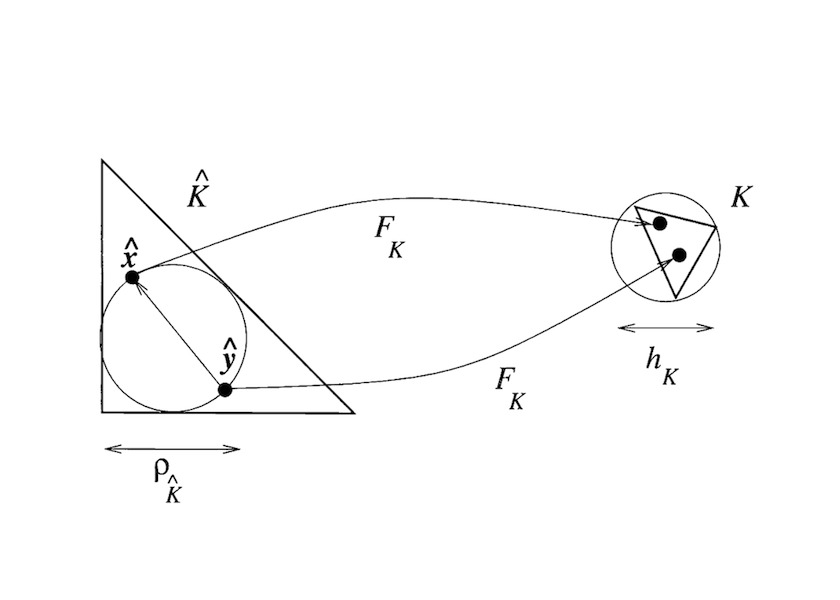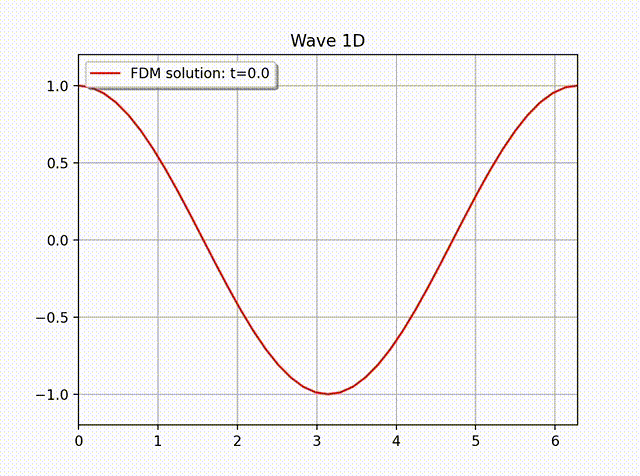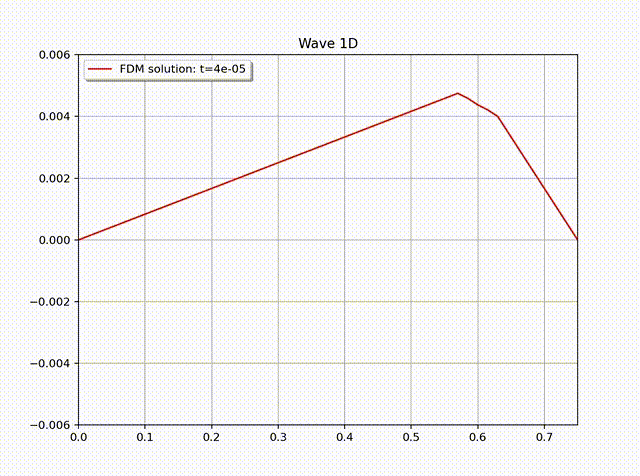A note on Gudi’s analysis of the IPDG method
Contact info: Kaifang Liu, kliu@yzu.edu.cn.
Introduction
Consider the 2nd-order elliptic equation\[ \begin{align*} -\nabla \cdot (\kappa \nabla u) &= f\quad \text{in}\ \Omega,\\ u &= 0\quad \text{on}\ \partial \Omega. \end{align*}\]The weak formulation is to find \(u \in V:=H^1_0(\Omega)\) s.t.\[ a(u,v) = (f,v)\quad v \in V, \tag{1}\]where \(a(u,v)=(\kappa\nabla u,\nabla v)\).
Since \(u \in V\) could have very low regularity, say \(u \in H^{1+s}(\Omega),\ 0< s <\frac{1}{2}\), the trace theorem in Sobolev spaces doesn’t work for \((\kappa\nabla u)_{|F}\) with \(F\) some face in a partition of \(\Omega\). This problem makes the consistency of interior-penalty discontinuous Galerkin (IPDG) unclear. Thanks to Gudi’s paper [1], an error analysis is introduced, where the low regularity case is included. Very recent progress on this problem is due to Ern and Guermond [2], they propose a generalized trace theorem for the minimal regularity functions and this provides low regularity analysis a powerful tool for elliptic and Maxwell equations.
In this note, we give an alternative proof for an estimate in Gudi’s method, where the author uses a result in a posteriori result without proof.
IPDG method
The IPDG formulation is to find \(u_h \in V_h\) s.t.\[ a_h(u_h,v) = (f,v)\quad \forall v \in V_h, \tag{2}\]where\[ a_h(w,v) = (\kappa\nabla w,\nabla v)-\int_{\mathcal{F}_h}[v]\left\{ \kappa\nabla w \right\}+[w]\left\{ \kappa\nabla v \right\}ds +\int_{\mathcal{F}_h}\frac{\sigma}{h}[w][v]ds.\]The notations for jumps and averages and meshes refer to [3]. Clearly, when we substitute \(u \in H^{1+s},s<\frac{1}{2}\) into \(a(u,v)\), one needs to justify \(\int_{\mathcal{F}_h}[v]\left\{ \nabla u \right\}\). This is the difficulty, see [2] for a generalized trace theorem. For our purpose, we first follow Gudi’s method.
To make clear, we list assumptions on \(a_h(u,v)\) to ensure the existence and uniqueness of weak formulation. For the energy norm\[ \|v\|_{1,h} = \left( \|\kappa^{1/2}\nabla v\|^2+\|h^{-1/2}[v]\|_{\mathcal{F}_h}^2 \right)^{1/2}, \tag{3}\]the bilinear form \(a_h(\cdot ,\cdot )\) satisfies
- Boundedness. \(a_h(w,v)\leq C\|w\|_{1,h} \|v\|_{1,h}\).
- Ellipticity. \(a_h(w,v)\geq \beta\|w\|_ {1,h} \|v\|_{1,h}\).
Error estimate
To be started, we set \(u,u_h\) are solutions to (1)(2), respectively. The error\[ u-u_h = (u-v) + (v-u_h),\quad \forall v \in V_h.\]We need to estimate \(\psi:= u_h-v\). Let \(\psi=\psi^c+\psi^\perp := \Pi_h \psi +(I-\Pi_h) \psi\), where \(\Pi_h\) is the \(H^1\)-conforming projection from \(V_h\) to \(V_h \cap V\) [4]. This decomposition plays an important role in the following analysis.
Theorem 1. We have the following estimate for \(u\) and \(u_h\): \[ \|u-u_h\|_ {1,h} \leq \frac{C}{\alpha} \left( h\inf_{z\in Z_h}\|f-z\|+ \inf_{\mathbf{q}\in W_h}\|\kappa \nabla u-\mathbf{q}\|+\inf_{v \in V_h}\|u-v\|_ {1,h} \right).\]
Proof. Using the coercivity, we have\[ \begin{align*} \alpha \|u_h-v\|_{1,h}^2 &\leq a_h(u_h-v,\psi)= a_h(u_h,\psi)-a_h(v,\psi)\\ &= (f,\psi)-a_h(v,\psi^c)-a_h(v,\psi^\perp )\\ &= (f,\psi^c)+(f,\psi^\perp)-a_h(v,\psi^c)-a_h(v,\psi^\perp )\\ &= a(u,\psi^c)-a_h(v,\psi^c)+(f,\psi^\perp)-a_h(v,\psi^\perp ). \end{align*} \tag{4}\]The first two terms on the right-hand side of (4) can be written as\[ \begin{align*} a(u,\psi^c)-a_h(v,\psi^c) &= (\kappa \nabla u, \nabla \psi^c)-(\kappa\nabla v,\nabla \psi^c) + \int_{\mathcal{F}_h}[v]\left\{ \kappa\nabla \psi^c \right\} ds\\ &\leq \|u-v\|_{1,h} \|\nabla \psi^c\|\\ &\leq \|u-v\|_{1,h} \|\psi\|_{1,h}. \end{align*} \tag{5}\]The last estimate follows properties of \(\Pi_h\), see [4].
The other two terms are different from Gudi’s. We shall use the quasi-interpolations from Ern [5]:\[ \mathcal{J}_h^d :H(\mathrm{div},\Omega)\to W_h,\quad \mathcal{J}_h^b :H(\mathrm{div},\Omega)\to Z_h,\]where \(W_h\) and \(Z_h\) are \(H(\mathrm{div})\) and \(L^2(\Omega)\) conforming finite element spaces, respectively. Moreover, they satisfy conmutative property:\[ \nabla \cdot \mathcal{J}_h^d \mathbf{q} = \mathcal{J}_h^b \nabla \cdot \mathbf{q},\quad \forall \mathbf{q}\in H(\mathrm{div},\Omega).\tag{6}\]Now, we have all tools to proceed.\[ \begin{align*} &(f,\psi^\perp)-a_h(v,\psi^\perp )\\ &=-(\nabla \cdot \kappa \nabla u, \psi^\perp )+a_h(v, \psi^\perp )\\ &=-(\nabla \cdot \kappa \nabla u – \mathcal{J}_h^b (\nabla \cdot \kappa \nabla u), \psi^\perp ) -( \nabla \cdot \mathcal{J}_h^d (\kappa \nabla u), \psi^\perp )+a_h(v, \psi^\perp ). \tag{7} \end{align*}\]Since \([u]=0\) on faces,\[ \begin{align*} &-( \nabla \cdot \mathcal{J}_h^d (\kappa \nabla u), \psi^\perp )+a_h(v, \psi^\perp )\\ &=( \mathcal{J}_ h^d (\kappa \nabla u), \nabla \psi^\perp )- \int_{\mathcal{F}_h}[\psi^\perp ]\left\{ \mathcal{J}_h^d (\kappa \nabla u) \right\} ds+a_h(v, \psi^\perp ) \\ &=( \mathcal{J}_ h^d (\kappa \nabla u)-\kappa \nabla v, \nabla \psi^\perp )- \int_{\mathcal{F}_h}[\psi^\perp ]\left\{ \mathcal{J}_h^d (\kappa \nabla u)-\kappa \nabla v \right\} ds \\ &+\int _{\mathcal{F}_h}[u-v ]\left\{ \kappa \nabla \psi^\perp \right\} ds + \int _{\mathcal{F}_h}\frac{\sigma}{h} [u-v] [\psi^\perp]ds. \\ &\leq C\left( \|\mathcal{J}_ h^d (\kappa \nabla u)-\kappa \nabla u\|+\|u-v\|_ {1,h} \right) \|\psi^\perp \|_{1,h}\\ &\leq C\left( \inf_{\mathbf{q}\in W_h}\|\kappa \nabla u-\mathbf{q}\|+\|u-v\|_ {1,h} \right) \|\psi \|_{1,h} \end{align*} \tag{8}\]Substituting (8) into (7) we have\[ (f,\psi^\perp)-a_h(v,\psi^\perp ) \leq C\left( h\inf_{z\in Z_h}\|f-z\|+ \inf_{\mathbf{q}\in W_h}\|\kappa \nabla u-\mathbf{q}\|+\|u-v\|_ {1,h} \right) \|\psi \|_{1,h}.\tag{9}\]Here, we have use the property that \(h^{-1}\|\psi^\perp \|\leq \|\psi\|_{1,h}\). Using estimates (5)(9) in (4), we obtain that\[ \|u_h-v\|_ {1,h} \leq \frac{C}{\alpha} \left( h\inf_{z\in Z_h}\|f-z\|+ \inf_{\mathbf{q}\in W_h}\|\kappa \nabla u-\mathbf{q}\|+\|u-v\|_ {1,h} \right). \tag{10}\]Therefore, triangle inequity with using (10) completes the proof.
References
[1] T. Gudi, “A new error analysis for discontinuous finite element methods for linear elliptic problems,” Mathematics of Computation, vol. 79, no. 272, pp. 2169–2169, 2010, doi: 10.1090/S0025-5718-10-02360-4.
[2] A. Ern and J.-L. Guermond, “Quasi-optimal Nonconforming Approximation of Elliptic PDEs with Contrasted Coefficients and \(H^{1+{r}},r>0\), Regularity,” Foundations of Computational Mathematics, pp. 1–36, Jul. 2021, doi: 10.1007/s10208-021-09527-7.
[3] B. Rivière, Discontinuous Galerkin Methods for Solving Elliptic and Parabolic Equations. Society for Industrial and Applied Mathematics, 2008. doi: 10.1137/1.9780898717440.
[4] O. A. Karakashian and F. Pascal, “A posteriori error estimates for a discontinuous Galerkin approximation of second-order elliptic problems,” SIAM Journal on Numerical Analysis, vol. 41, no. 6, pp. 2374–2399, Jul. 2003, doi: 10.1137/S0036142902405217.
[5] A. Ern and J.-L. Guermond, “Mollification in Strongly Lipschitz Domains with Application to Continuous and Discrete De Rham Complexes,” Computational Methods in Applied Mathematics, vol. 16, no. 1, pp. 51–75, Jan. 2016, doi: 10.1515/cmam-2015-0034.


